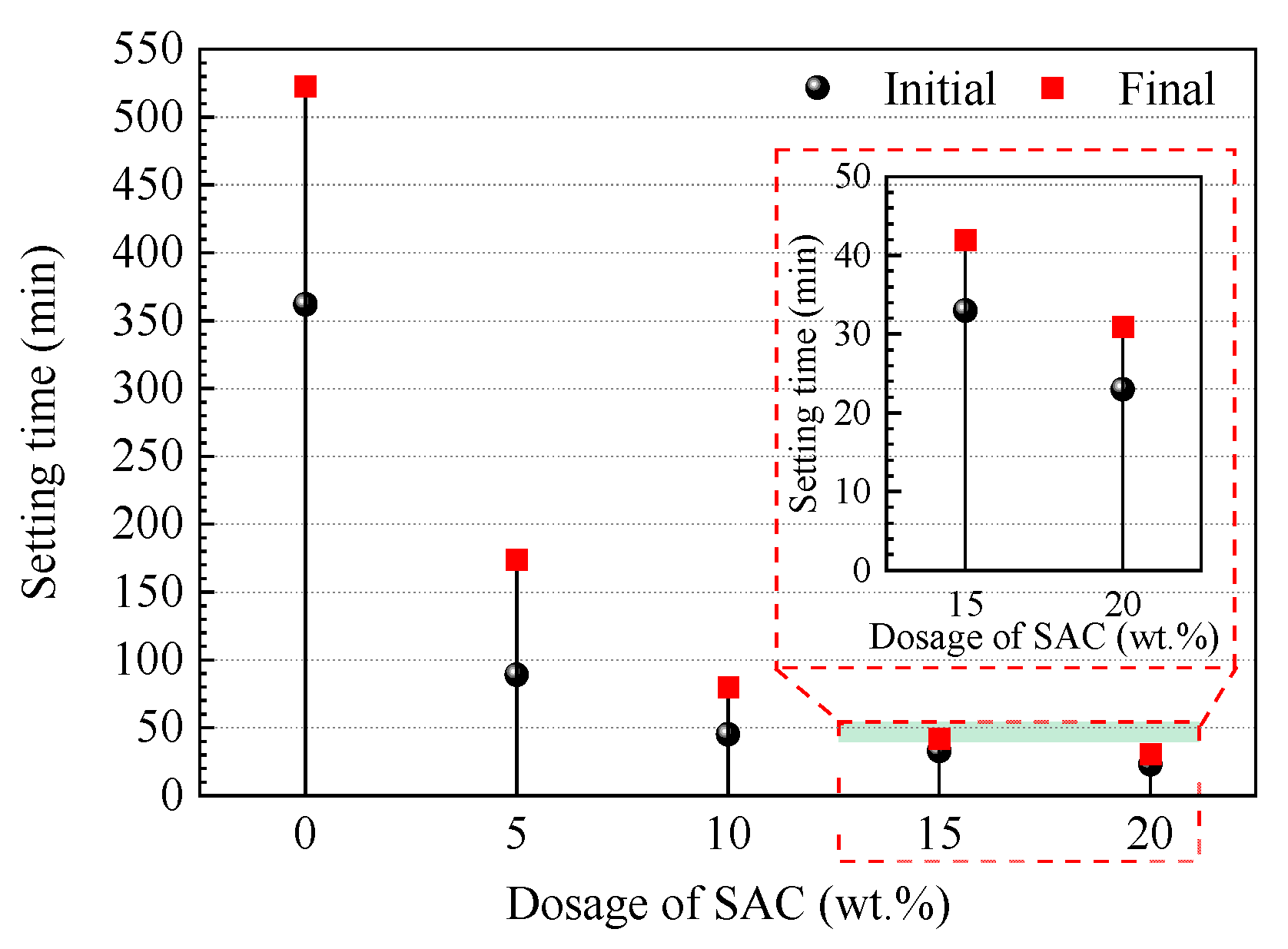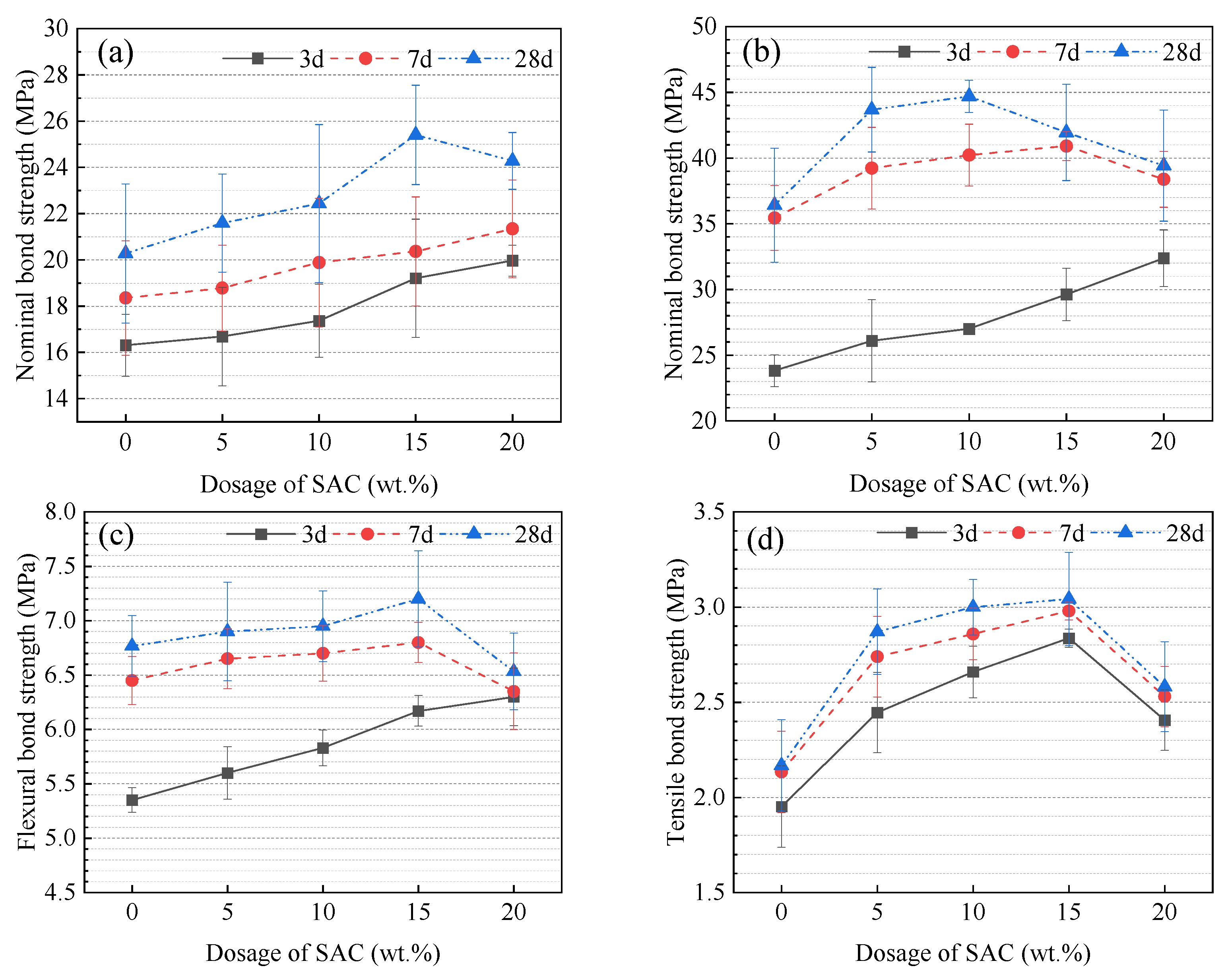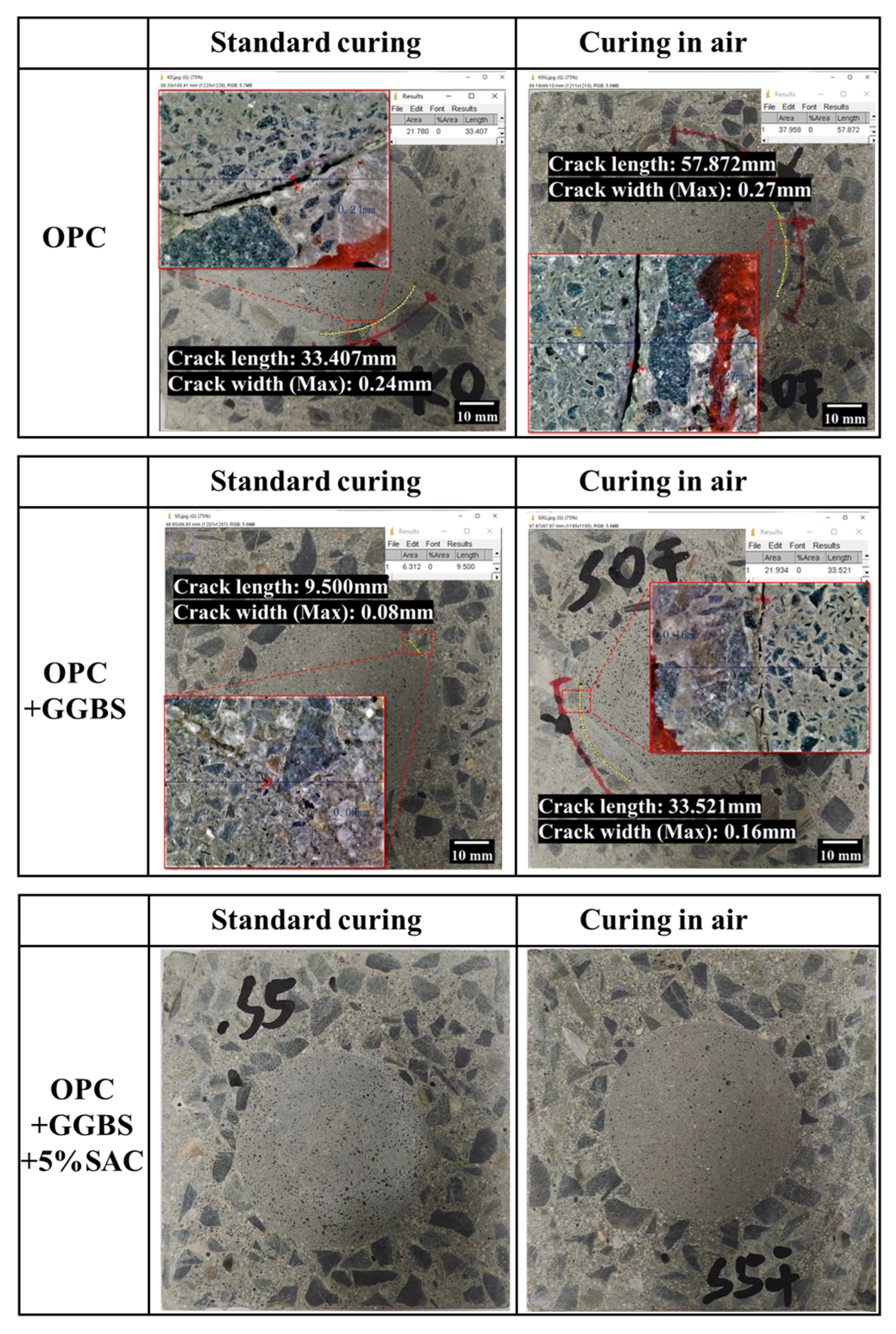Study on the Interfacial Bonding Behavior of OPC-GGBS-SAC Composite Repair Materials
Abstract
1. Introduction
2. Materials and Methods
2.1. Materials
2.2. Preparation of Samples
2.2.1. Preparation of the Repair Substrate
2.2.2. Preparation of Bonded Specimens
2.2.3. Preparation of OPC-GGBS-SAC Composite Repair Mortars
2.3. Measurement Method
2.3.1. Mechanical Properties and Setting Time
2.3.2. Bond Strength
- (1)
- Shear bonding strength
- (2)
- Flexural bonding strength
- (3)
- Tensile bonding strength
2.3.3. Expansion Properties
2.3.4. Heat of Hydration
2.3.5. Electric Flux
3. Results and Discussion
3.1. Setting Time
3.2. Mechanical Properties at Room Temperature
3.3. Mechanical Properties Under Negative Temperature
3.4. Bond Performance
3.5. Compensation Shrinkage Performance
3.6. Resistance to Chloride Ion Permeability
3.7. Heat of Hydration
3.8. Reliability Evaluation of Bonding Interface
3.9. Discussion
4. Conclusions
Author Contributions
Funding
Data Availability Statement
Conflicts of Interest
References
- Li, G.; Zhou, Q.; Wang, W.; Lu, C.; Chen, C.; Guo, Z.; Lu, C. Chloride diffusion along the interface between concrete matrix and repair materials under flexural loading. Constr. Build. Mater. 2023, 372, 130829. [Google Scholar] [CrossRef]
- Niu, M.; He, X.; Wang, Y.; Shen, Y.; Zhang, W.; Li, G. Performance degradation and chloride ion migration behavior of repaired bonding interfaces in seawater-freeze-thaw environment. Buildings 2025, 15, 2431. [Google Scholar] [CrossRef]
- Jia, L.; Jia, W.; Guo, J.; Sun, Y. Nano-silica-enhanced high-performance magnesium phosphate cement repair mortars: Optimization of interfacial bonding. Constr. Build. Mater. 2025, 490, 142447. [Google Scholar] [CrossRef]
- Semendary, A.; Dagmar, S. Factors affecting bond between precast concrete and cast in place ultra high performance concrete (UHPC). Eng. Struct. 2020, 216, 110746. [Google Scholar] [CrossRef]
- Lyu, J.; Feng, S.; Zhang, Q.; Xiao, H. Review of factors affecting bond strength between ultra-high-performance concrete and normal strength substrate. Constr. Build. Mater. 2024, 439, 137416. [Google Scholar] [CrossRef]
- Chen, P.; Li, Y.; Zhang, J.; Zhang, Z.; Wang, D. Influence of interface agent and form on the bonding performance and impermeability of ordinary concrete repaired with alkali-activated slag cementitious material. J. Build. Eng. 2024, 94, 110043. [Google Scholar] [CrossRef]
- Snoeck, D.; Wang, J.; Bentz, D.; De Belie, N. Applying a biodeposition layer to increase the bond of a repair mortar on a mortar substrate. Cem. Concr. Compos. 2018, 86, 30–39. [Google Scholar] [CrossRef]
- Mohammad, A.; Elke, G.; Kim, V.; Nico, B.; Nele, D. Treatment with nano-silica and bacteria to restore the reduced bond strength between concrete and repair mortar caused by aggressive removal techniques. Cem. Concr. Compos. 2021, 120, 104064. [Google Scholar] [CrossRef]
- Ummin, O.; Li, Y.; Li, K.; Chen, Y.; Jia, H.; Zuo, J. Influence of surface roughness and interfacial agent on the interface bonding characteristics of polyurethane concrete and cement concrete. J. Build. Eng. 2024, 91, 109596. [Google Scholar] [CrossRef]
- Zheng, H.; Pang, B.; Jin, Z.; Zhang, Y.; Hou, D.; Bi, J.; Zhang, W.; Yuan, L. Durability enhancement of cement-based repair mortars through waterborne polyurethane modification: Experimental characterization and molecular dynamics simulations. Constr. Build. Mater. 2024, 438, 137204. [Google Scholar] [CrossRef]
- Jia, L.; Zhao, F.; Yao, K.; Du, H. Bond performance of repair mortar made with magnesium phosphate cement and ferroaluminate cement. Constr. Build. Mater. 2021, 279, 122398. [Google Scholar] [CrossRef]
- Jin, Z.; Jing, S.; Pang, B.; Wang, P.; Chen, J.; Yang, C.; Song, X.; Liu, L. Sustainable infrastructure repair materials: Self-emulsifying waterborne epoxy enhanced CSA cement with superior shrinkage mitigation properties. Constr. Build. Mater. 2025, 490, 142432. [Google Scholar] [CrossRef]
- Hassan, B.; Steffen, G.; Stijn, M. Assessment of shrinkage and bond behaviour of high performance cement-based composites as a repair mortar. Dev. Built Environ. 2023, 15, 100203. [Google Scholar] [CrossRef]
- Hans, B.; Björn, H.; Marco, T. The influence of substrate moisture preparation on bond strength of concrete overlays and the microstructure of the OTZ. Cem. Concr. Res. 2017, 92, 84–91. [Google Scholar] [CrossRef]
- Momayez, A.; Ehsani, M.R.; Ramezanianpour, A.; Rajaie, H. Comparison of methods for evaluating bond strength between concrete substrate and repair materials. Cem. Concr. Res. 2005, 35, 748–757. [Google Scholar] [CrossRef]
- Zhang, S.; Yuan, Q.; Li, Q.; Zhang, F.; Xie, Z. Microstructural characteristics of bonding interfacial transition zone of concrete and magnesium ammonium phosphate cement. J. Build. Eng. 2023, 76, 107208. [Google Scholar] [CrossRef]
- Song, X.; Song, X.; Liu, H.; Huang, H.; Anvarovna, K.; Ugli, N.; Huang, Y.; Hu, J.; Wei, J.; Yu, Q. Cement-based repair materials and the interface with concrete substrates: Characterization, evaluation and improvement. Polymers 2022, 14, 1485. [Google Scholar] [CrossRef]
- Chen, Y.; Liu, Z.; Zhou, D.; Yuan, B.; Liu, S.; Luo, Z.; Li, X.; Jin, D.; Xu, F. Improving interfacial bonding between ordinary Portland cement and geopolymer concrete using acid/alkaline-catalyzed nano-SiO2 sols: Insights into performance and mechanisms. Constr. Build. Mater. 2025, 490, 142537. [Google Scholar] [CrossRef]
- Zhao, F.; Li, H.; Liu, S.; Chen, J. Preparation and properties of an environment friendly polymer-modified waterproof mortar. Constr. Build. Mater. 2011, 25, 2635–2638. [Google Scholar] [CrossRef]
- Gao, Y.; Luo, J.; Yuan, S.; Zhang, J.; Gao, S.; Zhu, M.; Li, Z.; Zhou, X. Fabrication of graphene oxide/fiber reinforced polymer cement mortar with remarkable repair and bonding properties. J. Mater. Res. Technol. 2023, 24, 9413–9433. [Google Scholar] [CrossRef]
- Zhang, P.; Du, M.; Fang, H.; Shi, M.; Zhang, C.; Wang, F. Polymer-modified cement mortars: Their enhanced properties, applications, prospects, and challenges. Constr. Build. Mater. 2021, 299, 124290. [Google Scholar] [CrossRef]
- Abdulrahman, P.; Bzeni, D. Bond strength evaluation of polymer modified cement mortar incorporated with polypropylene fibers. Case Stud. Constr. Mater. 2022, 17, e01387. [Google Scholar] [CrossRef]
- Li, Y.; Wang, J.; Gao, S.; Zheng, Y. Improvement effects of nano-silica on bonding performance of polymer concrete for repairing damaged concrete. Constr. Build. Mater. 2023, 409, 133768. [Google Scholar] [CrossRef]
- Chen, H.; Fan, Y.; Li, Q.; Luan, H. Effect of nano-metakaolin modified cement mortar binder on the bond performance and failure behavior of new-old concrete. J. Build. Eng. 2024, 98, 111426. [Google Scholar] [CrossRef]
- Masao, K.; Tomohide, W.; Nariaki, T. Increase of bond strength at interfacial transition zone by the use of fly ash. Cem. Concr. Res. 2000, 30, 253–258. [Google Scholar] [CrossRef]
- Zhang, T.; Tian, W.; Guo, Y.; Bogush, A.; Khayrulina, E.; Wei, J.; Yu, Q. The volumetric stability, chloride binding capacity and stability of the Portland cement-GBFS pastes: An approach from the viewpoint of hydration products. Constr. Build. Mater. 2019, 205, 357–367. [Google Scholar] [CrossRef]
- Juang, C.; Kuo, W. Properties and Mechanical Strength Analysis of Concrete Using Fly Ash, Ground Granulated Blast Furnace Slag and Various Superplasticizers. Buildings 2023, 13, 1644. [Google Scholar] [CrossRef]
- Han, J.; Jia, D.; Yan, P. Understanding the shrinkage compensating ability of type K expansive agent in concrete. Constr. Build. Mater. 2016, 116, 36–44. [Google Scholar] [CrossRef]
- Guo, X.; Liao, L.; Xie, K.; Xu, W.; Lu, L.; Huang, K. Early-age mechanical and shrinkage performance of CaO-MgO expansive agent self-compacting concrete. J. Build. Eng. 2025, 111, 113165. [Google Scholar] [CrossRef]
- Xiong, G.; Liu, J.; Li, G.; Xie, H. A way for improving interfacial transition zone between concrete substrate and repair materials. Cem. Concr. Res. 2002, 32, 1877–1881. [Google Scholar] [CrossRef]
- Niu, M.; He, X.; Zhang, X.; Liu, Z.; Shen, Y.; Li, G. The coordination effect of expansive agent and fly ash on the hydration behavior and expansion performance of cement-based grouting materials. Case Stud. Constr. Mater. 2025, 23, e05067. [Google Scholar] [CrossRef]
- Cao, F.; Yan, P. The influence of the hydration procedure of MgO expansive agent on the expansive behavior of shrinkage-compensating mortar. Constr. Build. Mater. 2019, 202, 162–168. [Google Scholar] [CrossRef]
- Feng, J.; Wang, K.; Ma, H.; Song, J.; Wang, J.; Sui, G.; Gu, L. Study on hydration characteristics of composite cementitious system with MgO expansion agent. Mater. Today Commun. 2025, 48, 113571. [Google Scholar] [CrossRef]
- Zhou, H.; Li, Y.; Ma, C.; Zhou, Z.; Fang, Z.; Lou, J.; Liu, Y. Bond performance and mechanisms of sulphoaluminate cement-based UHPC for reinforcing old concrete substrate. Constr. Build. Mater. 2023, 366, 130233. [Google Scholar] [CrossRef]
- Guo, C.; Wang, R. Using sulphoaluminate cement and calcium sulfate to modify the physical-chemical properties of Portland cement mortar for mechanized construction. Constr. Build. Mater. 2023, 367, 130252. [Google Scholar] [CrossRef]
- Afroughsabet, V.; Biolzi, L.; Monteiro, P.J.M.; Gastaldi, M.M. Investigation of the mechanical and durability properties of sustainable high performance concrete based on calcium sulfoaluminate cement. J. Build. Eng. 2021, 43, 102656. [Google Scholar] [CrossRef]
- Luo, W.; Liu, Y.; Lv, J.; Liu, H.; Li, H.; Chen, W. Mechanical and shrinkage properties of engineered cementitious composites with blended use of high-belite sulphoaluminate cement and ordinary Portland cement. J. Build. Eng. 2025, 106, 112551. [Google Scholar] [CrossRef]
- He, X.; Yang, J.; Niu, M.; Hanif, A.; Li, G. Contribution of layered double hydroxides to hydration and chloride binding capacity of OPC-SAC-GGBS repair materials. Constr. Build. Mater. 2024, 416, 135203. [Google Scholar] [CrossRef]
- Qian, J.; You, C.; Wang, Q.; Wang, H.; Jia, X. A method for assessing bond performance of cement-based repair materials. Constr. Build. Mater. 2014, 68, 307–313. [Google Scholar] [CrossRef]
- He, X.; Zhang, Y.; Hu, W.; Zhang, W.; Niu, M.; Li, G. Chloride Ion Binding Capacity and Mechanistic Study of OPC-GGBS Cement-Based Repair Materials. Mater. Repor. 2025, 1–12. Available online: https://link.cnki.net/urlid/50.1078.TB.20250520.1110.016 (accessed on 20 May 2025). (In Chinese).
- GB/T 1346-2024; Test Methods for Water Requirement of Standard Consistency, Setting Time and Soundness of the Portland Cement. Standards Press of China: Beijing, China, 2024.
- GB/T 17671-2021; Test Method of Cement Mortar Strength (ISO Method). Standards Press of China: Beijing, China, 2021.
- JGJ/T 299-2013; Technical Code for In-Site Testing of Building Waterproof Engineering. China Architecture & Building Press: Beijing, China, 2013.
- GB 23439-2017; Expansive Agents for Concrete. Standards Press of China: Beijing, China, 2017.
- GB/T 12959-2024; Test Methods for Heat of Hydration of Cement. Standards Press of China: Beijing, China, 2024.
- GB/T 50082-2024; Standard for Test Methods of Long-Term Performance and Durability of Concrete. China Architecture & Building Press: Beijing, China, 2024.
- Zhang, G.; Yang, Y.; Yang, H.; Li, H. Calcium sulphoaluminate cement used as mineral accelerator to improve the property of Portland cement at sub-zero temperature. Cem. Concr. Compos. 2020, 106, 103452. [Google Scholar] [CrossRef]
- Vahid, S.; Oveys, G.; Amin, G.; Mahdi, H.; Majid, M. Slant shear tests and fuzzy logic integration for evaluating shear bond strength in SCC and FRSCC repair applications. Case Stud. Constr. Mater. 2025, 22, e04176. [Google Scholar] [CrossRef]
- Liu, L.; Liu, Y.; Luo, Q.; Wang, J.; Yi, P.; Xie, X.; Xing, F. Investigation into the effect of sulfoaluminate cement on compressive strength and impermeability of Portland cement with alkali-free accelerator at low temperatures. J. Build. Eng. 2025, 101, 111948. [Google Scholar] [CrossRef]
- Zhang, J.; Li, G.; Yang, X.; Ren, S.; Song, Z. Study on a high strength ternary blend containing calcium sulfoaluminate cement/calcium aluminate cement/ordinary Portland cement. Constr. Build. Mater. 2018, 191, 544–553. [Google Scholar] [CrossRef]
- Xu, Y.; He, T.; Ma, X.; Luo, R. The influence of calcium sulphoaluminate cement on the hydration process of cement paste mixed with alkali free liquid accelerator. Mater. Today Commun. 2022, 33, 104622. [Google Scholar] [CrossRef]












| CaO | Al2O3 | SiO2 | Fe2O3 | MgO | SO3 | K2O | Na2O | LOI | |
|---|---|---|---|---|---|---|---|---|---|
| OPC | 63.23 | 5.29 | 20.38 | 2.98 | 2.11 | 2.46 | 0.37 | 0.15 | 3.03 |
| SAC | 42.25 | 36.46 | 6.86 | 2.20 | 1.33 | 8.82 | 0.18 | 0.22 | 1.25 |
| GGBS | 40.81 | 18.46 | 31.55 | 2.42 | 4.13 | 2.05 | 0.24 | 0.13 | 0.21 |
| Specific Surface Area (m2/kg) | Setting Time (min) | Compressive Strength (MPa) | |||||
|---|---|---|---|---|---|---|---|
| Initial | Final | 1 d | 3 d | 7 d | 28 d | ||
| OPC | 362 | 168 | 213 | / | 36.2 | 40.3 | 55.7 |
| SAC | 350 | 30 | 65 | 30.5 | / | 45.0 | 47.9 |
| 42.5 OPC | FA | GGBS | S | G | PCE | W | |
|---|---|---|---|---|---|---|---|
| Mortar substrate | 462 | 132 | 66 | 1320 | / | 0.66 | 231 |
| Concrete substrate | 350 | 80 | 70 | 790 | 900 | 0.90 | 160 |
| OPC (g) | GGBS (g) | SAC (g) | S (g) | PCE (g) | W/B | |
|---|---|---|---|---|---|---|
| S0 | 1000 | 300 | 0 | 1000 | 4.00 | 0.23 |
| S5 | 665 | 285 | 50 | 1000 | 4.00 | 0.23 |
| S10 | 630 | 270 | 100 | 1000 | 4.00 | 0.23 |
| S15 | 595 | 255 | 150 | 1000 | 4.00 | 0.23 |
| S20 | 560 | 240 | 200 | 1000 | 4.00 | 0.23 |
Disclaimer/Publisher’s Note: The statements, opinions and data contained in all publications are solely those of the individual author(s) and contributor(s) and not of MDPI and/or the editor(s). MDPI and/or the editor(s) disclaim responsibility for any injury to people or property resulting from any ideas, methods, instructions or products referred to in the content. |
© 2025 by the authors. Licensee MDPI, Basel, Switzerland. This article is an open access article distributed under the terms and conditions of the Creative Commons Attribution (CC BY) license (https://creativecommons.org/licenses/by/4.0/).
Share and Cite
He, X.; Zhang, W.; Liu, Y.; Zhang, Y.; Yu, Y.; Niu, M.; Li, G. Study on the Interfacial Bonding Behavior of OPC-GGBS-SAC Composite Repair Materials. Buildings 2025, 15, 4124. https://doi.org/10.3390/buildings15224124
He X, Zhang W, Liu Y, Zhang Y, Yu Y, Niu M, Li G. Study on the Interfacial Bonding Behavior of OPC-GGBS-SAC Composite Repair Materials. Buildings. 2025; 15(22):4124. https://doi.org/10.3390/buildings15224124
Chicago/Turabian StyleHe, Xiang, Wei Zhang, Yucong Liu, Yong Zhang, Yang Yu, Mengdie Niu, and Guoxin Li. 2025. "Study on the Interfacial Bonding Behavior of OPC-GGBS-SAC Composite Repair Materials" Buildings 15, no. 22: 4124. https://doi.org/10.3390/buildings15224124
APA StyleHe, X., Zhang, W., Liu, Y., Zhang, Y., Yu, Y., Niu, M., & Li, G. (2025). Study on the Interfacial Bonding Behavior of OPC-GGBS-SAC Composite Repair Materials. Buildings, 15(22), 4124. https://doi.org/10.3390/buildings15224124





